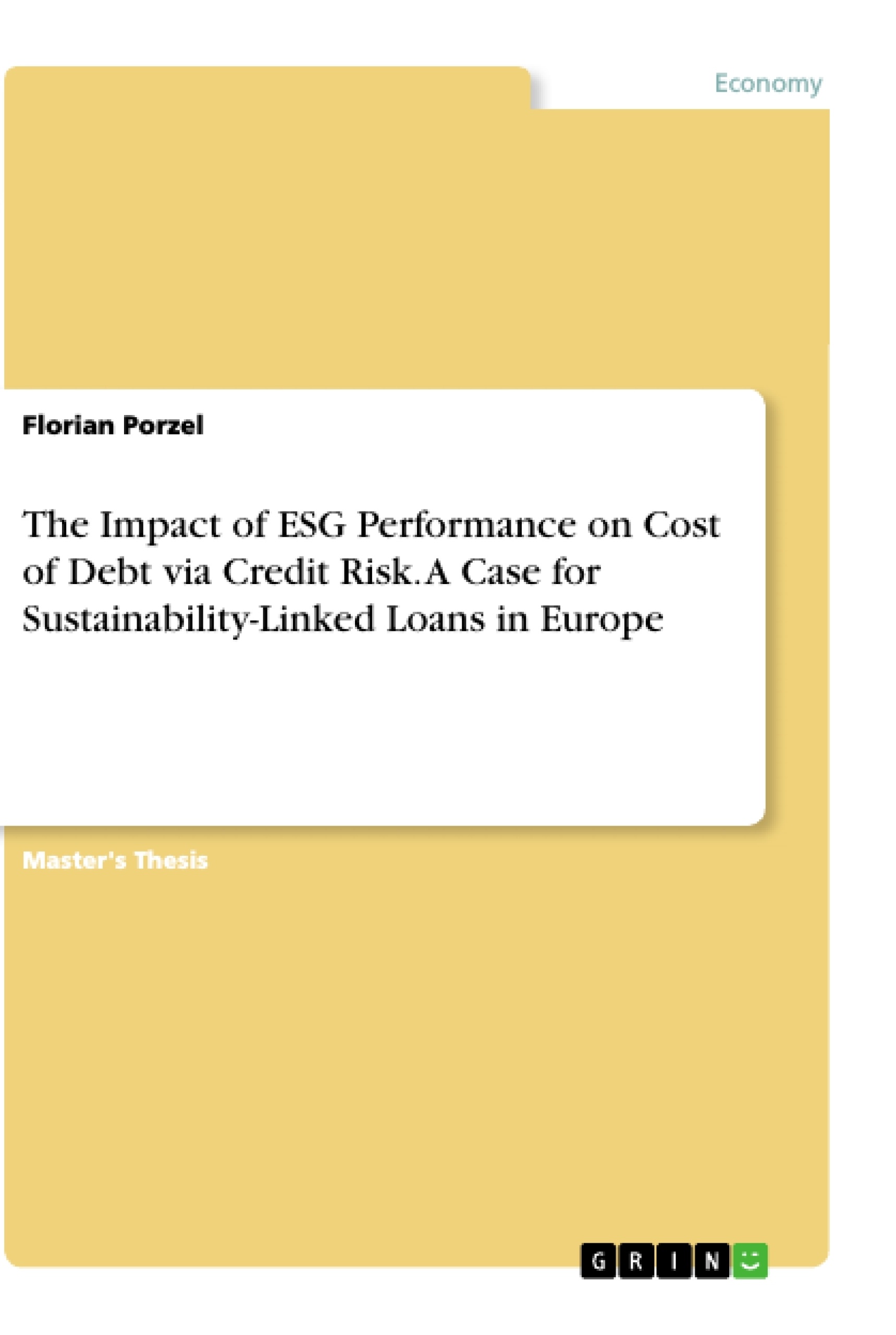This thesis, graded with summa cum laude, examines the effect of Corporate Social Responsibility (CSR) expressed through Environmental, Social, and Governance (ESG) scores on firms’ cost of debt on two distinct layers with a particular interest on the economic mechanism through which sustainability performance unfolds. Three distinct economic channels for the effect of corporate sustainability on the cost of debt capital are established, namely governance strengths, information asymmetry, and credit risk. The work provides evidence that the latter is primarily responsible for lower debt premia to sustainable borrowers. First, on firm-level, it is shown that superior ESG performance can offset cost of debt by 0.45% for a one standard deviation improvement on ESG performance.
In current times of global climate stress with environmental anomalies happening at a daily rate, business actions are understood to play the pivotal role in fighting the most pressing concern in contemporary human history – the transition towards a sustainable economic model. In fact, in order to reach the ambitious sustainability target set by the European Union to reach carbon neutrality by 2050, additional sustainable investments of EUR175 to EUR290 billion are in demand annually. As such, the scaling up of private sector investments entered as key element into the EU Sustainable Finance Action Plan launched by the European Commission in 2018. And although the first climate change bankruptcy with PG&E Corp. failing to meet potential liabilities of around USD30 billion resulting from wildfires already occurred, the need for sustainable adaptation of business practices is erroneously evaluated against hypothetical scenarios or a debatable model of the long-term effects of change.
Inhaltsverzeichnis (Table of Contents)
- 1 Introduction
- 2 Theoretical Foundation and Hypothesis Development
- 2.1 Corporate Social Responsibility
- 2.2 The Role of ESG in Corporate Finance
- 2.2.1 ESG and Firm Performance
- 2.2.2 ESG and Cost of Capital
- 2.3 Credit Risk in the ESG - Cost of Debt Relation
- 3 Data and Methodology
- 3.1 Data for the ESG-COD Relationship
- 3.1.1 Firm-Level Argument
- 3.1.2 Loan-Level Argument
- 3.2 Variable Construction for the ESG-CoD Relationship
- 3.2.1 Firm-Level Argument
- 3.2.2 Loan-Level Argument
- 3.3 Methodology for the ESG-COD Relationship
- 3.3.1 Firm-Level Empirical Model
- 3.3.2 Loan-Level Empirical Model
- 3.4 Empirical Model for the Credit Risk Impact
- 3.1 Data for the ESG-COD Relationship
- 4 Results
- 4.1 Analysis on the ESG-COD Relationship
- 4.2 Analysis on the Credit Risk Channel
- 4.3 Robustness Checks
- 4.3.1 Alternative Model Specifications
- 4.3.2 Addressing Endogeneity Concerns
- 5 Conclusion
Zielsetzung und Themenschwerpunkte (Objectives and Key Themes)
This master's thesis aims to investigate the impact of Environmental, Social, and Governance (ESG) performance on firms' cost of debt. The thesis explores this relationship through the lens of credit risk, examining how sustainable companies benefit from lower debt premia due to their reduced risk profile. The study utilizes firm-level and loan-level data to provide a comprehensive analysis of the ESG-cost of debt relationship.
- The role of ESG performance in reducing credit risk
- The impact of sustainability performance on cost of debt
- The effectiveness of sustainability-linked loans in lowering financing costs for ESG-performing companies
- The significance of ESG factors in credit risk assessments
- The practical implications of integrating ESG considerations into corporate financing and credit risk analysis
Zusammenfassung der Kapitel (Chapter Summaries)
The introductory chapter sets the stage for the research by providing an overview of the topic and outlining the key research questions. It introduces the concept of corporate social responsibility (CSR) and its significance in the context of ESG performance. Chapter 2 delves into the theoretical foundations of the study, examining the role of ESG in corporate finance and the relationship between ESG and cost of capital. This chapter also discusses the specific role of credit risk in the ESG-cost of debt relationship. Chapter 3 presents the data and methodology used in the thesis, outlining the firm-level and loan-level data sources, variable construction, and empirical model specifications. The results of the study are presented in Chapter 4, analyzing the relationship between ESG performance and cost of debt, exploring the credit risk channel, and conducting robustness checks.
Schlüsselwörter (Keywords)
This research focuses on the intersection of Corporate Finance and Sustainable Finance. It examines the influence of Corporate Social Responsibility (CSR) expressed through Environmental, Social, and Governance (ESG) scores on firms' Cost of Capital, specifically Cost of Debt. Key themes include the role of Credit Risk in the ESG-Cost of Debt relationship, the effectiveness of Sustainability-Linked Loans, and the implications of integrating ESG considerations into traditional credit risk assessments.
- Quote paper
- Florian Porzel (Author), 2020, The Impact of ESG Performance on Cost of Debt via Credit Risk. A Case for Sustainability-Linked Loans in Europe, Munich, GRIN Verlag, https://www.grin.com/document/988243




